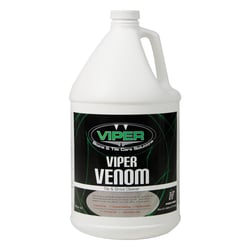Tile & grout has grown significantly in market share over the last 20 years. The cleaning issue is in the grout since it is so absorbent. A professional cleaning was often ignored as it required a lot of tedious brush scrubbing and inconsistent extraction.
Special cleaning tools and specialized cleaning solutions made grout much easier to clean in a shorter time. Behold, a new diversification that when used with a truckmount made tile and grout easy and profitable to clean came into being.
General maintenance cleaning removes the dirt from the tile and is absorbed by the mop or the grout. White grout over time turns black as the deposits of oils and soils collect on its surface. Cleaners now have an easy solution and now bring to the customer's attention dirty grout in their homes and the businesses that they frequent. This has spurred the growth of professional grout cleaning as a result of changing the standard of cleaning.
Professional cleaners have demanded cleaning solutions that deal with the months of soil build-up. The result was high-alkaline tile and grout cleaner. This type of formula was designed for use on difficult oily & particulate soil found in the grout surrounding ceramic and porcelain tile. These formulas generally contain chelates that can alter the colors of the mineral in stone. This balanced high alkaline-based solvent and surfactant cleaner will remove years of built-up grease and soil. It works best when combined with pressure & heat while using the high-pressure rotary extraction tools.
These professional solutions provide diverse alkalinity with pH > 12.0 for multiple cleaning functions. The widespread use of sodium hydroxide provides the bulk of alkalinity that effectively breaks oil, grease, and fat into smaller particles. The inclusion of sodium silicate assists the suspension of these smaller particles and prevents their re-deposition for easier rinsing. The presence of phosphate helps to rinse away the globs of soil and oils created by emulsification. Some formulas have a potassium phosphate which balances the sodium ions resulting in formula stability in the bottle. One downside is that the level of available alkalinity does require that its shipping classification be considered a hazardous material.
Most of these formulas also use solvency and surfactancy for additional emulsification. It is common to use a volatile and non-volatile solvent in the formula to prolong the emulsification process during its extended dwell time. This balance enables it to meet California VOC requirements while possessing enough solvent to do its part in the emulsification process.
Fragrance softens the odor of the volatile solvents and in the case of d'limonene adds degreasing functionality. Most formulas blend non-ionic and anionic surfactants to assist in emulsification and penetration of the solution into porous surfaces. Functionally the blend enables a greater concentration of raw materials to form a clear, and stable formula.
In short, high pH alkaline cleaners have found their niche in their frequent use in cleaning tile and grout. Several additional choices have been made available in the intervening years.
Featured Products

Hydro-Force Hard Surface Cleaner Viper Venom Tile & Grout Cleaner, 1 Gallon
